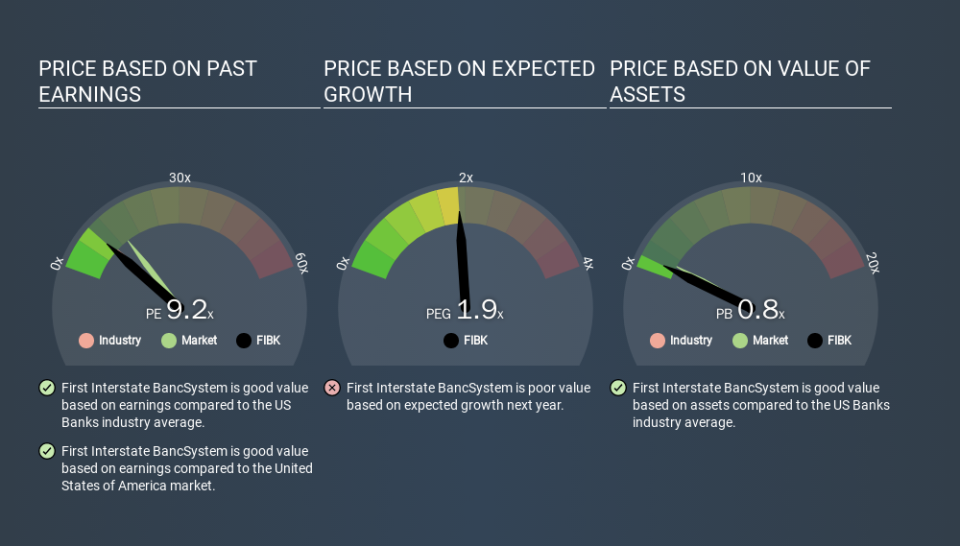How Does First Interstate BancSystem's (NASDAQ:FIBK) P/E Compare To Its Industry, After The Share Price Drop?

To the annoyance of some shareholders, First Interstate BancSystem (NASDAQ:FIBK) shares are down a considerable 34% in the last month. Indeed the recent decline has arguably caused some bitterness for shareholders who have held through the 37% drop over twelve months.
Assuming nothing else has changed, a lower share price makes a stock more attractive to potential buyers. While the market sentiment towards a stock is very changeable, in the long run, the share price will tend to move in the same direction as earnings per share. The implication here is that long term investors have an opportunity when expectations of a company are too low. One way to gauge market expectations of a stock is to look at its Price to Earnings Ratio (PE Ratio). A high P/E implies that investors have high expectations of what a company can achieve compared to a company with a low P/E ratio.
Check out our latest analysis for First Interstate BancSystem
How Does First Interstate BancSystem's P/E Ratio Compare To Its Peers?
First Interstate BancSystem has a P/E ratio of 9.20. The image below shows that First Interstate BancSystem has a P/E ratio that is roughly in line with the banks industry average (9.4).
First Interstate BancSystem's P/E tells us that market participants think its prospects are roughly in line with its industry. So if First Interstate BancSystem actually outperforms its peers going forward, that should be a positive for the share price. I would further inform my view by checking insider buying and selling., among other things.
How Growth Rates Impact P/E Ratios
Earnings growth rates have a big influence on P/E ratios. That's because companies that grow earnings per share quickly will rapidly increase the 'E' in the equation. Therefore, even if you pay a high multiple of earnings now, that multiple will become lower in the future. So while a stock may look expensive based on past earnings, it could be cheap based on future earnings.
First Interstate BancSystem increased earnings per share by 2.6% last year. And earnings per share have improved by 8.5% annually, over the last five years.
Don't Forget: The P/E Does Not Account For Debt or Bank Deposits
The 'Price' in P/E reflects the market capitalization of the company. So it won't reflect the advantage of cash, or disadvantage of debt. Hypothetically, a company could reduce its future P/E ratio by spending its cash (or taking on debt) to achieve higher earnings.
Such expenditure might be good or bad, in the long term, but the point here is that the balance sheet is not reflected by this ratio.
How Does First Interstate BancSystem's Debt Impact Its P/E Ratio?
First Interstate BancSystem has net debt equal to 31% of its market cap. You'd want to be aware of this fact, but it doesn't bother us.
The Verdict On First Interstate BancSystem's P/E Ratio
First Interstate BancSystem's P/E is 9.2 which is below average (12.7) in the US market. The company hasn't stretched its balance sheet, and earnings are improving. If you believe growth will continue - or even increase - then the low P/E may signify opportunity. What can be absolutely certain is that the market has become more pessimistic about First Interstate BancSystem over the last month, with the P/E ratio falling from 13.9 back then to 9.2 today. For those who prefer invest in growth, this stock apparently offers limited promise, but the deep value investors may find the pessimism around this stock enticing.
Investors should be looking to buy stocks that the market is wrong about. If it is underestimating a company, investors can make money by buying and holding the shares until the market corrects itself. So this free visualization of the analyst consensus on future earnings could help you make the right decision about whether to buy, sell, or hold.
Of course, you might find a fantastic investment by looking at a few good candidates. So take a peek at this free list of companies with modest (or no) debt, trading on a P/E below 20.
If you spot an error that warrants correction, please contact the editor at editorial-team@simplywallst.com. This article by Simply Wall St is general in nature. It does not constitute a recommendation to buy or sell any stock, and does not take account of your objectives, or your financial situation. Simply Wall St has no position in the stocks mentioned.
We aim to bring you long-term focused research analysis driven by fundamental data. Note that our analysis may not factor in the latest price-sensitive company announcements or qualitative material. Thank you for reading.

